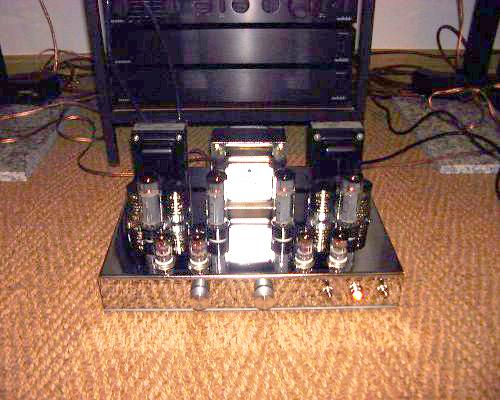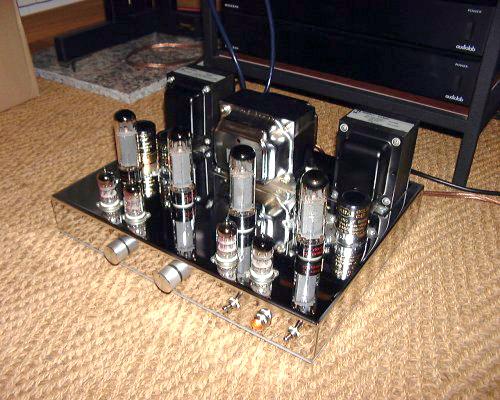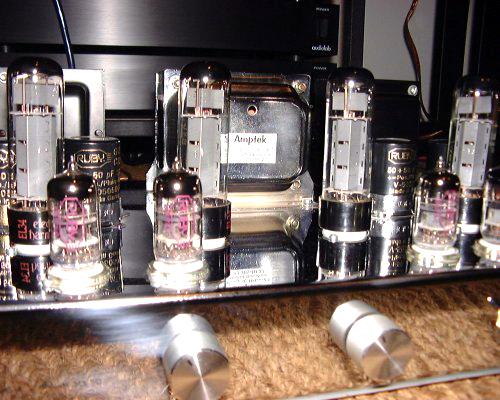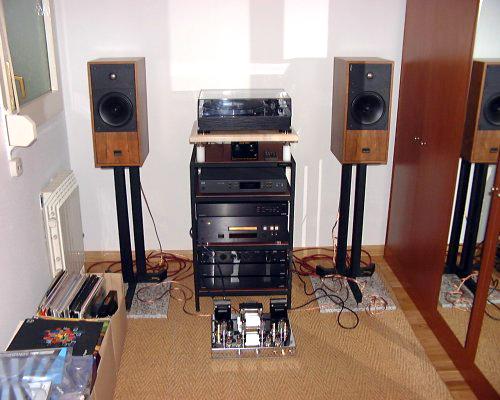

| [ George Hi-Fi 50/50 integrated tube amplifier] |
This is an audition that I would have done some time ago but the daily work and other circumstances have delayed. To me is special to give my impressions about this amplifier because it is a design that I have seen from its beginning coming from Jorge Bueno's mind. Jorge Bueno is my personal guru on tube themes and a true expert on this subject. He is the head at Amptek, a little spanish company devoted to the manufacture of professional tube amplification equipment for musicians and also hi-fi tube equipment for audio lovers. Jorge has a universitary degree in Telecommunications Engineering and before creating Amptek he worked in this field. But for the joy and pleasure of the tube lovers he decided to establish his company some years ago. I must certify that Jorge has a deep, very deep knowledge on electronics and on tube equipment. His speciality is the professional tube amplification equipment for musicians, mainly classic designs. He knows every classic design as if he was the designer. Many times I have seen Jorge talking on the phone with somebody and describing a whole circuit of an amplifier without using any circuit diagram. All coming from his memory. Jorge also contributes with his articles to the spanish journal Guitarra Total and since 2000 he has the offical technical service for all the products distributed in Spain by Thorens Ibérica. Amptek also imports a huge number of electronic parts to Spain, like Sprague capacitors, Electro-Harmonix tubes and Ruby Tubes, Hammond trasnformers and much more. If you are a tube lover and you live in Spain and you need information about tube gear or you need that electronic component difficult to find, Amptek and Jorge Bueno are the solution. And at least, but not last, Jorge is musician and to all this theorical and technical kowledge we must add a trained ear. Do you want any more?


The amplifier we are talking about is the George Hi-Fi 50/50. It is an integrated amplifier delivering 40-45 watts per channel, in ultralinear push-pull configuration and operating in Class AB. It uses 4 Ruby Tubes 12AU7 (Philips made) in the preamplifier section and 4 Electro-Harmonix EL34 power tubes (the best reedition available today of the original Mullard EL34 power tube). Other features include: hand wired circuit, point-to-point wired and soldered with high quality solder (no integrated circuits used), 2mm thick iron chassis, Hammond 1650P ultralinear output transformers, Amptek custom made power transformer, Sprague Orange Drop signal capacitors, Ruby Gold Caps electrolityc caps, ceramic sockets for all tubes, Alps Blue Velvet volume pot, three line inputs with 500mv of sensitivity and 4,8 and 16 ohms loudspeaker connections.


The philosophy of this design is to offer to the audiophile the highest possible level of quality with a reasonable price and with all the possibilities to modify and upgrade the unit. This is very usual in countries like the UK and the USA where the audio DIY (do-it-yourself) is widely extended. I must admit that these objectives are fully accomplished. It is very difficult to find (at least, in Spain) an amplifier using these components with this price (1052 euros, including VAT). To those that don't have information about audio parts and components I must inform that all the parts are top quality and that you can find them in high quality equipment from Sonic Frontiers (Hammond output transformers, the key in any tube amplifier), NAD and Musical Fidelity (Alps volume pot), etc, etc. In addition to that and due to that the circuit is hand wired and point-to-point soldered (remember, no integrated circuits) the amplifier accepts any kind of component upgrade. In fact, Amptek offers different upgrades to this excellent basic model and some of them include the change of signal capacitors (Sprague to Hovland Musicap), change of volume pot (Alps to Noble), change in power tubes ( EL34 to KT 66), class AB to class A, etc. Even Amptek is ready to accept custom modifications from a given customer and special hot roddings. Do you want more electrical reserve or a regulated power supply (a lá Red Rose Music, the last experience from Mr. Mark Levinson)?. Any tube lover will find this design very convenient, because of its high quality parts and easiness of upgrade. Only few aesthetical details must be improved. Two pairs of rubber of metal feet, wood sides and a protection cover (when you read this, the protection cover will be probably available) would give to the amplifier the final touch.
The audition of the George Hi-Fi 50/50 took place at my home for almost two weeks. This is the first time that I have an amplifier on test for such a long period and in a so familiar environment like my own home. As you can imagine this has allowed me to have a close impression of this unit. Not only I tested it my my main equipment, but also with my week-end equipment, I mean classic amplifiers and some ESL57 panels.

Let's see the behaviour of this amplifier working with my main equipment. (see image above). This is an "unfriendly environment" for tubes, mainly due to my speakers, a pair of Epos ES14 with 87 db/1w/1m of sensitivity at 8 ohms. A point about that.....many times some audio lovers ask me about tube amplifiers and what kind of loudspeakers to use with them. This example (Epos with 87 dB with tubes) it is not the best combination. I must admit, in fact, that it's bad. These speakers have a low sensitivity and the amplifier with only 40 watts was not comfortable working with them. No, the problem is not the amplifier, but the speakres that aren't appropriate. But these are my speakers... To use with low powered amplifiers (below 35 watts) I would recommend speakers with a sensitivity about 90dB-91dB at 8 ohms. Much is better, but normally expensive. Sources were a TEAC VRDS10 SE CD player and a Thorens TD 166 BC MK VI with SME 3009 SIII tonearm and a Benz Micro Silver cartridge. Phono preamp was an EAR 834P (modified with Alps Blue Velvet volume pot and GE 5751 tubes).
The sound form the George 50/50 amplifier could be defined as hybrid (that sounds awful!). Let me explain. I mean that while having the typical signature of tube amplifiers it was able to produce strong bass lines like the ones usually found in solid state amplifiers. It also has the dynamic, control and speed of this kind of amplifiers, but all with the sweet sound of tubes. One of the improvements that I found while listening, and that made the audition very enjoyable, was the reduction of the treble extreme that in my configuration is a little bit excessive (room needs treatment). I tested many of my favourite records. Real and well defined voices (Diana Krall, Ella Fitzgerald...), the piano specially well reproduced (Oscar Peterson: The Trio. Live in Chicago) and the bass well controled (Pat Metheny-John Scofield: I can see your house from here). In the first moment this surprised me, because in most of my experiences with tube amplifiers, most of them classic designs, that bass lines were not so good. But then come to my mind an article that you could find at TNT-Audio where the writer compared two versions of the Dynaco ST 70 and they found similar results due to differences in the circuit design of both amps. Talking with Jorge Bueno after my test, he told me that my first impressions were rigth and that this sound was due to solid state rectification and modern capacitors.
One of the big surprises of the behavior of the amplifier, talking at a componenet level, was that of the output transformers. The Hammond 1650P is able to deliver 60 watts of power output without problems. In this configuration they deliver only 45 watts, which represents only a 75% of the total amount of available power. So, the output transformers work easilly and it can be seen when touching them after long listening sessions. They are completely cold. This means that you can use the amp for long periods without problems. Another good element are the power tubes, a matched quartet of Electro-Harmonix EL34, the best EL34 on the market and very close to the original Mullard according the hi-fi press (Ken Kessler at Hi-Fi News and Charlie Kittleson at Vacuum Tube Valley). I agree with that.
After many days sharing my musical experiences with my neighbour (he built some tube amps when he was young. He stopped doing that when everybody tolds him that the tube was dead. BTW, he is still impressed with this amp) I moved the amp to the place were I have my week-end system, a more "convenient" place for tubes. Classic tube hi-fi and so. There I used the amplifer with boxed speakers, Kef Q15 (recommended for tube use by the experts at Vacuum Tube Valley) and a pair of Vieta Allegro. Both speakres have been selected because are valve friendly. As I said before, when working with low powered tube amps (less than 35 watts) it is better to use high sensitivity speakers. The Q15 have a sensitivity of 91 dB / 6 ohms and the Vieta de 91 dB / 8 ohmns and this make them easy to drive with amplifiers with 15-20 watts of power output.
The result of this combination was very good. The excelent results of the test with my Epos speakres were confirmed and exceeded. Now in this tube friendly environment, I confirmed my first impressions, specially those about bass control and dynamics usually found in solid state amps but with the sweet sound of tubes.
Then I tested the amplifier with the Quad ESL57. The sound was good but it wasn't as I suposed. Perhaps it was due to the reason that I listen to this speakers with their natural partners, the Quad II amplifiers and they offer a special signature, but I didn't like the sound. I must admit that the ESL57 is a very special speaker and perhaps they didn't match. So the test was short because I imagined another sound after listening to the amplifier with my other speakers. But this happens in hi-fi. This make me think about the question if this modern tube design works best with modern speakers. Perhaps those differences in the circuit layout make it better in other environment. Back from the ESL57 to the Q15 and Vieta, things were very good again.
After that sessions with my classic gear I could listen again the amplifier with my Epos speakers during long listening sessions (three days) and I must confirm that the amplifier sounds very, very good. From a subjective point of view this second audition sounded better to me. Now the amplifier dissapeared and only the music was present. Very enjoyable, my neighbour and I enjoying. This is the main reason of high fidelity.
Finally and as a resume. I had a great time with this amplifier and I had also great facilities. An this not happens usually. So, thanks Jorge. About the amplifier, at the construction level there's nothing to say. Components are top quality, reliable and after the test I can say that durables. If we add to that, that the amplifier can be upgraded and even custom made at a moderate price I can say that is difficult to find an amplifier with this quality-price relation. About the sound it can be described as "valve sound with the bite of solid state". With the permission of Jean-Luc Picard, the best of both worlds?